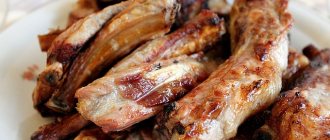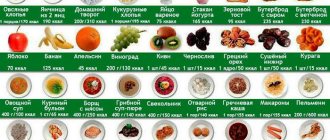What is the essence of the weight loss method?
Carbohydrates provide the body with the necessary amount of energy, which is spent during the day on vital processes and during physical activity. A complete refusal of a macronutrient will lead to malfunctions in the functioning of functional systems, and a surplus of energy received will lead to an increase in fat reserves. A low-carbohydrate diet includes slow (complex) carbohydrates, which do not cause a strong spike in blood sugar and take longer to convert into energy.
The essence of the method is that from the first day of the diet for safe and effective weight loss, every day the amount of carbohydrates consumed is reduced, and proteins increase. Thanks to this, the following processes are launched in the body:
- Previously received energy is in short supply, which forces us to look for a new source.
- In the first 2-3 days of the diet, glycogen becomes the main supplier of energy.
- Next, fats are broken down, synthesizing an additional source of energy - ketone.
Studies comparing the benefits of low-carb and low-fat diets for weight loss found that people who minimized carbohydrates lost more weight over 6 months than those who followed a low-fat diet.
With a low-carbohydrate diet, subjects felt fuller after eating because proteins and fats break down more slowly than carbohydrates. In addition, the increase in blood sugar levels and insulin production occurred gradually. This means that they did not have sudden bursts of energy, which are replaced by fatigue and an increased feeling of hunger.
Conclusion : the principle of the diet is biochemical processes that promote fat burning and loss of extra pounds.
It is important to remember that during a diet, the fat layer is uniformly reduced throughout the body, so it is impossible to reduce volumes locally.
Advantages and disadvantages
The low carbohydrate content in the menu has a beneficial effect on the body's condition, normalizing digestion, increasing metabolic processes and rejuvenating.
Pros:
- on a diet there is no hunger, strength remains at the same level, there is no weakness;
- suitable for diabetics;
- suitable nutrition for men and women for the purpose of losing weight;
- Suitable for low, medium and high activity levels;
- does not require a significant change in the calculation of daily calorie needs when losing weight, the indicators of proteins and carbohydrates change.
Reducing the amount of macronutrients helps to lose weight and improve health, recommended for:
- overweight;
- intense training;
- diabetes mellitus;
- hypertension;
- endocrine system disorders;
- oncological diseases.
The method has gained confidence among athletes and competitive bodybuilders - it is a reliable opportunity to gain relief by reducing the percentage of subcutaneous fat and maintaining muscle mass.
However, the diet has disadvantages:
- constipation - a decrease in fiber, which is associated with a reduction in carbohydrate intake, can lead to digestive problems;
- carbohydrate starvation can cause headaches, irritability and nervousness;
- exacerbation of chronic diseases;
- increases the load on the liver;
- potassium and sodium are in short supply;
- carbohydrate deficiency reduces concentration, which is critical for people engaged in mental work;
- an increase in cholesterol levels due to a large amount of animal products, which provokes the development of diseases of the cardiovascular system;
A low-carb diet is not on the list of methods that can be followed for several years, since a large list of prohibited foods creates additional stress for the body. Therefore, after several weeks or months of restrictions, a person returns to his usual diet.
Balance of proteins, fats, carbohydrates
The main source of protein on a low-carb diet is animal products: meat, poultry, offal, cottage cheese, eggs. For vegetarians, legumes and nuts are an alternative.
The ratio of BJU in the diet is within:
- Proteins 40-50%;
- Fats 30-35%;
- Carbohydrates 20-25%.
Hypocarbohydrate diet for weight loss
Among a large number of different diets, low-carbohydrate programs occupy a prominent and, rightfully, deservedly honored place.
The most famous of these diets:
- Kremlin;
- Atkins;
- Protasova;
- Protein;
- Dukan;
- Ketogenic diet;
- Whole30;
- Mediterranean.
Some studies have shown that following a low-carb diet for six months leads to greater weight loss than other traditional diets.
Low-carbohydrate foods severely reduce the intake of refined sugar into the body and stimulate fat burning - this is what is associated with the effectiveness of the diet.
The basis of a hypocarbohydrate diet for weight loss is that the amount of carbohydrates consumed should not exceed 40-50 grams per day. Under such conditions, the process of ketosis is launched, which consists of the breakdown of accumulated fats in order to obtain energy and maintain metabolism.
Low carb diet rules
Exceeding the prescribed carbohydrate limit is not allowed.
Completely excluded:
- flour;
- canned food;
- sweets;
- carbonated drinks;
- fast food;
- semi-finished products;
- sausages;
- potato;
- cereals;
- sweet fruits;
- alcohol.
The main diet consists of protein foods:
- bird;
- eggs;
- lean meat;
- seafood;
- fish;
- cheeses;
- cottage cheese;
- kefir;
- unsweetened yoghurts.
The number of vegetables and fruits allowed is limited:
- unsweetened berries and apples;
- tomatoes;
- mushrooms;
- cucumbers;
- cabbage;
- onion;
- leaf salads;
- eggplants.
The number of meals is 4-5 times a day, in small portions. Be sure to drink a large volume of clean water - 1.5–2.5 liters per day. Low-carbohydrate programs allow virtually unlimited consumption of protein foods.
But it should be borne in mind that this can often be high-calorie and fatty food at the same time. Therefore, it is necessary to choose lean varieties of meat and fish, carefully study the information on packages of packaged products, give preference to cooking methods that involve minimal use of fat, and monitor the daily amount of calories.
Low-carbohydrate diets are contraindicated for liver and kidney diseases. Due to the manifestation of ketosis, the load on all organs increases, dehydration may occur, poor health and insomnia develop, and mental activity decreases due to lack of glucose.
If the drinking regime is not followed, the body becomes intoxicated. Weight loss can be significant, but it is worth limiting the time frame for such a diet.
Opinion of nutritionists
Nutritionists speak with caution about the method, because a low-carbohydrate diet (for a week or a month) involves consuming 50-70 g of macronutrients per day. Deficiency leads to undesirable disorders with a number of side effects, just like surplus.
Doctors recommend giving preference to a proper and balanced diet, controlling the intake of carbohydrate foods. Healthy eating habits combined with physical activity will help reduce the amount of fat deposits - the method cannot be classified as express weight loss, but without harm to health.
Basic rules of a no-carbohydrate diet
- Count calories to create your own diet. You can take a ready-made balanced program, but then it will not reflect your taste preferences, and it will be difficult not to “break” into carbohydrate foods. We'll tell you how to count calories below.
- Organize a fractional diet - eat about 5-6 times a day. It is best to prepare the required amount of food for the whole day in advance, and eat as hunger sets in. At the same time, carefully monitor your feeling of fullness and stop as soon as the hunger passes. If you eat slowly, there will be no problems.
- Drink at least 2 liters of water per day. Just pure water, not tea, coffee or juice.
- 4 hours before bedtime you need to eat your last meal. If you break this rule, the effectiveness of the diet will be lower.
- Avoid fried foods. They are not prohibited, but boiled food is healthier for the body. And it is best to fill the fat norm with salads with a small amount of olive oil.
- The last meal should be without carbohydrates.
- In the first half of the day, it is allowed to eat cereals, but not any kind - it is advisable to limit yourself to buckwheat and oatmeal.
- It is not recommended to be on a low-carb diet for more than three weeks. For the first time, it is better to limit yourself to one week and repeat the diet after a two-week break. During the break, you should also eat in moderation, then the diet will have a quick effect.
Contraindications
Before “going on a diet,” you should consult a doctor, since high protein foods are contraindicated for people with metabolic disorders (for example, urolithiasis, gout).
The fact is that with a normal diet, these metabolic disorders may not appear, which means you may not even know that you have the disease. By changing your diet to increase protein consumption, you provoke the launch of a severe pathological mechanism in your body.
Excessive consumption of fatty foods is contraindicated for gastrointestinal diseases (cholecystitis, pancreatitis, cholelithiasis, stomach ulcers, gastritis). Fatty foods provoke the intake of large amounts of cholesterol into the body, which can cause the occurrence or accelerate the growth of atherosclerotic plaques.
The weight loss method is also not recommended:
- pregnant and lactating women;
- persons under 18 years of age;
- for cardiovascular diseases;
- at the time of exacerbation of chronic diseases.
Basic rules of a low-carb diet
The method involves consuming a minimum portion of carbohydrates sufficient to maintain the functioning of the body. For women, 2 grams per kilogram of weight is required, for men - 3 g. If the daily intake is 120-150 g, then for weight loss the figure gradually and gradually decreases to 50-70 g per day. Protein food becomes a substitute source of energy and maintains muscle tone.
A low carbohydrate diet lowers insulin levels, which suppresses appetite. Ketone bodies, which come from animal and vegetable proteins and fats, block the flow of information about the feeling of hunger.
Following some principles will help you achieve your goals:
- exclude products with a high glycemic index from the diet;
- take additional vitamins and minerals;
- The preferred cooking method is stewing, boiling, grilling, steaming. Fry the ingredients without adding oil or with a small amount;
- do not skip meals or reduce calories;
- Intake complex carbohydrates in the first half and before training, in the second - protein foods;
- be sure to have breakfast;
- maintain a drinking regime: at least 2 liters of clean liquid.
Do not forget that correct calculation of the daily energy requirement when losing weight is the first step before starting any diet.
Daily carbohydrate intake
For a healthy adult, the average carbohydrate intake per day ranges from 100 to 200 g.
However, this number will be subject to significant fluctuations, taking into account:
- age;
- floor;
- weight;
- level of physical activity;
- existing diseases.
Based on the fact that 1 g of any carbohydrate product contains 4 calories, the required amount of food is calculated according to the goals set.
The lack of physical activity and 4 g of carbohydrates per kilogram of body weight ensure that the existing weight is maintained at a constant level. If the goal is to lose weight, and active training is not possible, then the carbohydrate intake should be reduced to 2 g per kilogram. With a regular high level of activity, it is possible to adhere to the 4 g norm and observe a decrease in body weight.
You should choose foods that are low in carbohydrates rather than thinking that all carbohydrates are bad.
It is not recommended to set the amount of carbohydrates at the level of 1 g per day per kilogram, especially in the presence of physical activity, since this is a significant stress for the body and leads to the development of ketoacidosis and severe chronic diseases.
Initial daily values can be assumed based on data on the level of physical activity and the person’s age. The higher your age, the less carbohydrates you need to consume.
For women who perform only intellectual work, 80-90 g per day is enough; at light loads - from 85 to 95 g; moderate loads – 95 – 100 g; sports or physical labor - 100-116 g of carbohydrates per day.
Men who do not have loads can use:
- from 93 to 100 g per day;
- with light loads - 101-110 g of carbohydrates;
- average physical activity – 108 – 132 g;
- sports or physical labor - 140 - 158 g per day.
Authorized Products
The list of products to support a low-carb diet is extensive, which will diversify the menu and prevent you from starving. It is important to study the information about the component using food calorie tables or on the label.
Table of permitted products
The diet implies certain restrictions. Using the table, you can familiarize yourself with foods suitable for a low-carbohydrate diet.
| Product groups | Authorized Products |
| Meat | Lean pork, veal and beef, poultry, offal |
| Fish and seafood | Sea fish: salmon, salmon, cod, mackerel, herring, tuna, halibut Seafood - unlimited |
| Milk products | Cottage cheese, cheese, kefir, natural yogurt without additives - all with a low fat content |
| Eggs | Chicken and quail |
| Vegetables, raw and canned | Everything except vegetables with a high starch content: potatoes, Jerusalem artichoke, sweet potato |
| Mushrooms | No restrictions of any kind |
| Fruits, berries | Citrus fruits, green non-sweet apples |
| Cereals | Long-cooked oatmeal, brown rice and buckwheat |
| Nuts and seeds | No limits |
| Oil | Vegetable unrefined |
| Sauces | Balsamic vinegar |
| Sweeteners | Free of sorbitol and fructose |
| Beverages | Coffee, tea - no added sugar, mineral water, vegetable juices |
Prohibited Products
If your favorite product is not on the list of allowed ingredients, then most likely it is on the prohibited list:
- bakery and confectionery products;
- processed cereals (white rice, instant oatmeal, semolina), premium wheat pasta;
- potatoes, corn;
- semi-finished products, smoked products;
- food ingredients (mayonnaise, ketchups and sauces, excluding soy sauce);
- chocolate;
- sweet fruits (banana, grapes);
- sugar and sugar products;
- packaged juices, fruit drinks (due to added sugar);
- soda;
- alcoholic drinks.
It is necessary to abandon the above products for the first time, and after 3-4 weeks gradually introduce them back into the diet in small portions.
How to reduce the amount of carbohydrates in your diet
The transition to reducing the amount of carbohydrates should be carried out gradually and systematically. A sharp reduction in glucose sources will lead to a deterioration in health, causing drowsiness and fatigue, irritability or apathy. A full analysis of the existing diet and the development of a plan to adjust it to the optimal level is necessary.
Video about low carb foods and weight loss:
https://youtu.be/b2A-gw0zE34
- Determination of foods containing carbohydrates . Compiling a list of such products will allow you to rationally determine the content of simple and complex carbohydrates.
- Preference for protein foods . Each meal includes a protein-rich main dish and complements it with a serving of salad or unsweetened fruit.
- Limit starch intake . Replace high-starch foods with green vegetables and fresh fruits.
- Product processing methods . Avoiding all kinds of batters and breadings, additional sauces and fats. Meat or fish are baked in the oven or fried in a pan without adding oil.
- Limit portion sizes . During the day, 4-5 meals are allowed, in small portions. Weighing and counting foods will help you create the optimal menu and control your carbohydrate intake.
- The right choice of drinks . Refusal of strong alcohol and sugary drinks. Alcohol contains quite a lot of carbohydrates, and it also provokes an increase in appetite. Packaged and fresh juices are full of pure sugar, high in calories, and lack healthy fiber. It is possible to add a small amount of honey or a sugar substitute to hot drinks.
Products that are low in complex carbohydrates are excluded from the diet. The rest are distributed in accordance with the desired consumption rate.
Sample menu for the week
At first glance, it seems that a low-carbohydrate diet does not differ in variety, but by preparing a menu for the week in advance, you can make sure that the diet is rich. An alternative menu for the week can be taken from the following video.
Table: sample menu of a low-carb diet for 7 days
The table contains possible combinations of breakfasts, lunches and dinners, which can be taken as a basis and replaced with your favorite meal. Do not forget that it is important to correctly calculate the calorie content of the prepared dish in order to comply with the daily norm of energy consumption. It is possible to alternate and repeat products.
| Day | Breakfast | 2nd breakfast | Dinner | Afternoon snack | Dinner |
| 1 day | Sugar-free cottage cheese casserole + tomato/cucumber | Grapefruit | Brown rice porridge with vegetables | Kefir 1% | Steamed fish + cabbage salad + bread |
| Day 2 | Scrambled eggs or two-egg omelette + chicken | Low-fat cottage cheese | Mushroom soup with low-fat sour cream + bread | Kefir 1% with chopped cucumber and herbs | Boiled beef + cucumber and tomato salad |
| Day 3 | Stewed vegetables with grated cheese | Apple | Vegetable soup with chicken broth | Milk 1.5% | Boiled breast + stewed cabbage |
| 4 day | Oatmeal with grated apple | Grapefruit | Buckwheat porridge + beet salad | Low-fat cottage cheese | Veal or chicken stew with vegetables |
| 5 day | Cheese + boiled eggs | Apple | Boiled brown rice + seafood | Kefir 1% | Vegetable salad + lean beef steak |
| Day 6 | Cheese + boiled egg + bread | Natural yoghurt without sugar 1.5% | Baked meat + vegetable salad | Kiwi | Stewed vegetables + boiled fish |
| Day 7 | Milk buckwheat porridge | Low-fat cottage cheese | Fish baked with vegetables | Kefir 1% | Baked breast + fresh vegetables and herbs |
A long-term low-carb diet (30 days or more) should include a cheat meal or refeed to avoid a slowdown in metabolism.
List of products
On a hypocarbohydrate diet, there is a fairly extensive list of foods allowed for consumption. These include:
- any type of meat: lamb, beef, pork, veal, chicken;
- vegetables: raw, canned, boiled;
- mushrooms;
- nuts and seeds;
- sea fish and seafood;
- low-fat dairy products;
- chicken and quail eggs;
- brown rice, buckwheat, oatmeal (in limited quantities);
- soy;
- unsweetened fruits.
Prohibited:
- starchy vegetables: potatoes, beets, corn, peas;
- baked goods, muffins, bread;
- sweets, sugar;
- pasta;
- sausages;
- butter;
- mayonnaise, sour cream and fatty sauces;
- honey;
- dried fruits;
- bananas, grapes;
- sweet soda;
- alcoholic drinks.
You can eat fat-containing foods, but in moderation.
Quitting the diet
A low-carbohydrate diet is effective and affordable, but after 2 months you need to return to your normal diet. The exit is done gradually in order to minimize stress on the body and not regain previously lost kilograms.
Return to normal diet in 3-4 weeks:
- in the first and second weeks, the amount of fruits and vegetables (not containing starch) increases;
- third week – reduction of protein foods by adding cereals;
- the number of calories is also increasing every day.
The benefits and harms of carbohydrates
Carbohydrates are the “fuel” for the functioning of the brain and central nervous system, ensuring the functioning of the heart and muscles. In addition, they affect memory and mood, increase cognitive abilities and speed of decision-making. Approximately 50-60% of the body’s energy needs are met through carbohydrates, and 40% through fats and proteins.
Fiber contained in carbohydrate foods improves digestion and intestinal function, maintains normal cholesterol levels, and also prevents the development of stomach cancer.
Pectin and starch are also components of high-carbohydrate foods. They provide a feeling of satiety, help remove harmful substances, and saturate with glucose. However, the excessive presence of carbohydrate foods in the diet leads to serious negative consequences.
The main problems are:
- excess weight;
- development of diabetes;
- high blood pressure.
Consumption of simple carbohydrates is accompanied by an increase in sugar, which the body transfers to fat deposits, trying to quickly establish normal glucose levels. This makes you feel tired and hungry. There is a need for additional food intake, most often sweets.
Sugar dependence appears, metabolism is disrupted, and obesity and diabetes can develop.
A complete rejection of foods rich in carbohydrates is undesirable for the body; it can lead to a lack of nutrients and the manifestation of various diseases. Low-carbohydrate foods, chosen correctly, will allow you to maintain balance and minimize possible harm.











